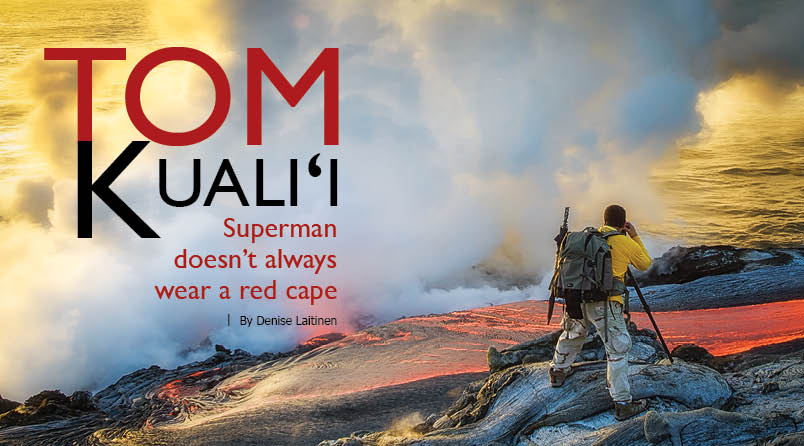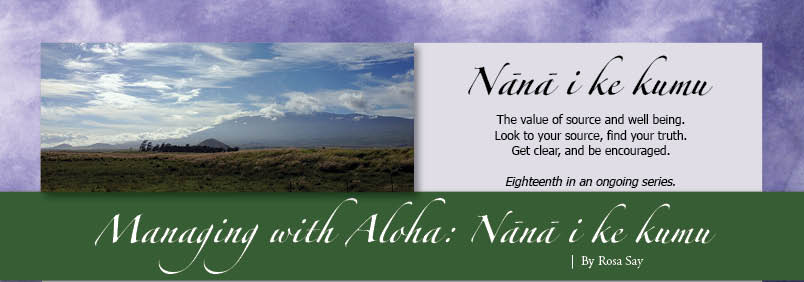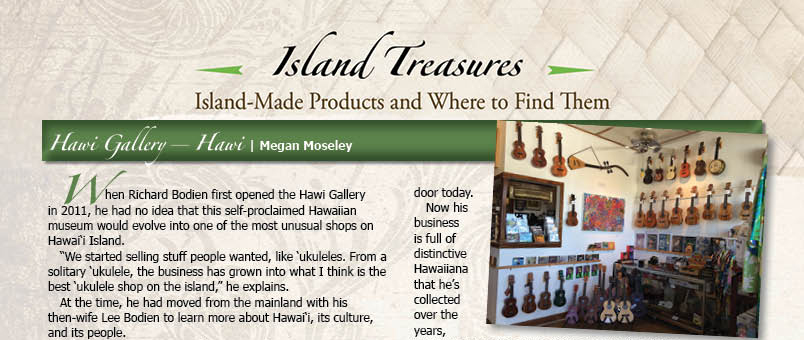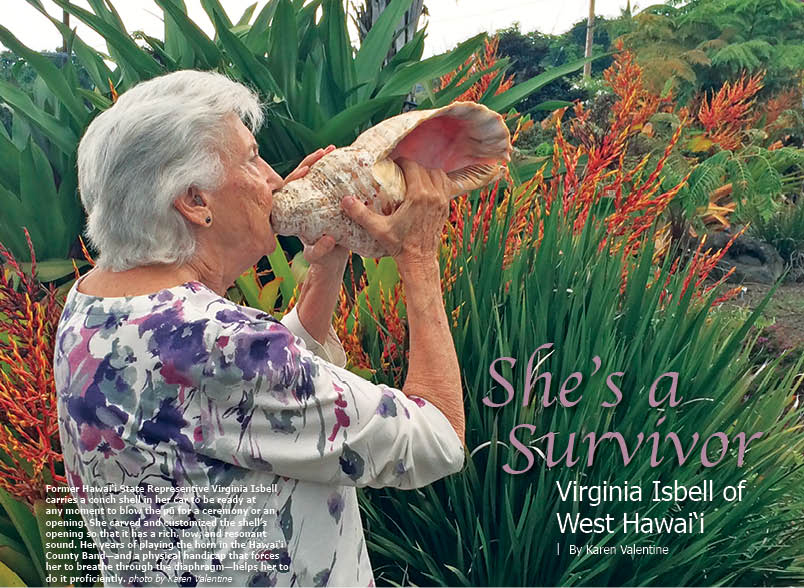
Tom Kuali‘i: Superman Doesn’t Always Wear a Red Cape

By Denise Laitinen
Veteran’s Day is November 11, and in this article we highlight a Hawai‘i Island veteran who has served both our country and our island community. We write of Tom Kuali‘i. This is Tom’s story.
Sometimes supermen wear camouflage instead of a red cape; and sometimes they are called “Dad.” They serve our country, raise a family, and make the world a better place.
Ever humble, Tom Kuali‘i would be the first to deny he’s a superman, however his actions speak louder than his words. A veteran whose military career spanned two decades and included a tour of duty in Iraq, Tom has spent years dealing with the effects of post-traumatic stress disorder (PTSD); yet he works full-time as a heavy equipment operator and in his spare time is an award-winning photographer. Indeed, his lava-related images appear in galleries and venues across Hawai‘i and as far away as New York. Tom also co-owns a successful fine art gallery in downtown Hilo. All of this on top of being a single father raising four daughters.
A Native Hawaiian whose family traces its genealogy back for centuries, Tom was born and raised in Hilo, the oldest of four children. After graduating Waiakea High School, he joined the Hawaii National Guard and earned an associates’ degree at Hawai‘i Community College (HCC).
While at HCC, he picked up photography as a hobby and took a couple of photography classes. At the time, he had no idea of the impact the military or photography would have on his life. He continued his education on O‘ahu, studying athletic training at BYU and then UH Mānoa. Tom also continued with his military training, transferring to the 12 93rd aviation unit based at Wheeler Army Airfield. As part of his service, he participated in training one weekend a month and two weeks a year.
Tom says the idea of pursuing a career either in photography or in the military never occurred to him.
“I was studying physical education and coaching women’s volleyball,” he says.
Life has a funny way of moving in unexpected directions. He fell in love, got married, and the babies started coming in quick succession. By the time his third daughter was born, Tom gave up his studies to work full-time supporting his family. In all, the couple had four girls: Britni, Taetum, Codi, and Meagan. When his youngest daughter was still a toddler, the couple divorced and Tom moved back to Hilo with full custody of his four daughters.
“When I moved back in 1998, I was still active in my National Guard unit….I wound up working actively with them on a full-time basis for three years.” Since his National Guard work was based on annual contracts and fluctuating budgets, Tom sought out more permanent work.
“I got hired by DPW Highways [County of Hawai‘i Department of Public Works] and continued working with the National Guard on a part-time basis.”
In 2004, Tom and his unit received word that they were being deployed to Iraq. He took military leave without pay from his job at Public Works and prepared to head to a war zone.
Over the years, Tom had risen through the National Guard ranks, so when his unit deployed he was an E6 Staff Sargent responsible for 11 soldiers under his command.
“Our squad was able to stay together,” explains Tom. “When you’re in the National Guard and get called up, you get attached to a company, but we were able to stay together as a whole unit. All together there were 250 to 300 people in our company.”
While he was happy that he would remain with his fellow Hawai‘i soldiers, he says leaving his daughters was the hardest thing he ever did.
“My daughters were 9, 11, 13, and 15 at the time. I still have this picture in my head of when I said goodbye to them that day. My youngest daughter Meagan was crying and holding onto my leg. I had to forcibly pull her off my leg and tell my parents to take her because I had to get on the bus to leave.”
“My daughters lived with my parents while I was deployed, and my sister was a big help.”
Tom and his unit spent a total of three months preparing for their deployment, first on O‘ahu and then in Kuwait.
After Kuwait, his squad was stationed at Balad, the largest military air base in Iraq. Located 50 miles north of Baghdad, the base was a central hub for airlift operations, for U.S. supply convoys and the U.S. Air Force.
As an aviation unit supporting the troops in Iraq, they were responsible for managing aviation fuels and refueling aircraft. Tom and his men weren’t just responsible for refueling National Guard helicopters and planes; he says, “We were responsible for whatever units were deployed in the entire country.”
“When we got to Balad it was summer and the hottest it got was 127 degrees. It was a dry heat,” he says with a wry grin. “We couldn’t wait for winter. But when winter came, it was terrible. We couldn’t wait for summer again. It was cold, wet and really muddy.”
The weather was the least of their worries.
“Mortar rounds would come in when we were on base. When we first got there and a mortar round came in, we were scared and tried to get into protective barriers. As time went by, we got more used to it and would walk around as the base got shelled. It made work challenging, but we adjusted.”
In addition to working at Balad, “We had a mission in Najaf when fighting heated up in that area. At the time Najaf was the front line: and we set up a temporary base just outside the city where soldiers would come to resupply and refuel.”
Tom says one of the toughest parts of his deployment was the four months he spent providing support for a diplomatic security detail in Baghdad.
“They only needed two people and my job was to assign those two people. Knowing that it was a bad place, I volunteered myself and asked for another volunteer.” Tom says it was very different working in the capital of the country as opposed to a remote military base.
“Balad was surrounded by farm land for as far as the eye could see. Insurgents attacked us with a variety of weapons on an almost daily basis. Baghdad, however, is the capital of Iraq—a busy urban center—and you couldn’t tell the difference between insurgents and civilians. Gun fire and car bombings were regular occurrences.”
When not dodging mortar rounds or refueling aircraft, Tom fell back on an old hobby to pass the time—photography. Right before he headed overseas he purchased his first digital camera, a Canon 10D.
“I knew only the basics from my classes at HCC. From there I expanded by reading and learning online; I was all self taught.”
“On our days off I consumed myself with photography. Mostly I was taking pictures of what we were doing. It took my mind off things.”
“I gained a liking for photography and the ability to post process images. Post processing is a huge part of digital photography,” says Tom. “I learned how to take images as well as process them. I really enjoyed it.”
While in Iraq, Tom entered a photography contest sponsored by British manufacturer Hescobastion. The grand prize was a brand new limited edition 2005 Harley Davidson motorcycle.
“When I submitted my photo I didn’t expect to win because there were 700 entries. While I was in Baghdad I was notified I was the grand prize winner. Since I was still in Iraq, the company waited until I returned to Hawai‘i before giving me the motorcycle.”
When his unit’s in country deployment was finished, Tom and his fellow soldiers still had to undergo two months of post-duty processing in Kuwait and O‘ahu before he could be reunited with his kids. In all, he was away for 18 months.
True to its word, Hescobastion was waiting with his grand prize motorcycle when he returned to Hilo.
“The company sent two reps from London. They had a big ceremony and presented me with the bike and even trailered it to my house.”
Tom had sold his car before being deployed and was about to restart his job at Public Works, so he needed a car to get to work. Since he needed a vehicle to drive his four daughters around, he sold the bike and bought a truck that he owns to this day.
He returned to what was familiar, yet things were not the same. Like many veterans returning from combat duty, Tom suffers from PTSD and often has trouble sleeping. “To this day I have a hard time with loud, sudden noises.
“It was such a struggle for me because I had to work a full-time job. I had to take care of my kids. And then I had to manage my PTSD and manage the problems connected to my inability to sleep.”
As he did in Iraq, Tom turned to photography as a way to take his mind off things.
He looked for times, usually weekends or holidays, when he could go into nature and shoot photographs.
“Every time I go out into nature or visit Pele, I find it’s a happy place, a comfort place. I enjoy photography so when I came back I pursued it more. The photography doesn’t make the PTSD any easier, but it makes me happier.”
“I want to be the best photographer I can be; so I squeezed photography in between raising four kids and working full-time.”
On top of all this, Tom remained active in the National Guard and in 2008 he received word that his unit was being sent back to Iraq.
“I wanted to go and I actually expected to go. I remember sitting down with my girls after I got the call and telling them that Dad’s going back to Iraq.”
“Even to this day it puts a gulp in my throat. My girls cried. It broke my heart. It made me realize what they went through during my first deployment. I knew they had suffered while I was gone, but I didn’t know just how much they had gone through.”
Tom says he realized that as much as he wanted to be with his military family, he didn’t want to put his daughters through another deployment. The following day he called his unit and told them he was retiring after more than 25 years with the National Guard.
He didn’t know it at the time, but that decision enabled him to be present for the next turn in his career. The same year, Tom met fellow photographer Bruce Omori, whose daughter played on the same soccer team as one of Tom’s daughters. At the same time, lava from Kīlauea volcano started flowing into the ocean, and the County created a public viewing area in Kalapana. Tom and Bruce started going on hikes to photograph the lava’s ocean entry.
“I partnered with Bruce in 2008 when the lava flow started. We took pictures of the lava and put up a tent at the public lava viewing area where we sold our photographs.” Tom and Bruce formed a company called Extreme Exposure and quickly built a reputation for their top-notch lava photography.
When the lava stopped flowing into the ocean a few years later, the pair decided to launch their own gallery. In 2010, they opened Extreme Exposure Fine Art Gallery in downtown Hilo. Tom and Bruce’s work is now on display at galleries and venues across the state, including the Polynesian Cultural Center on O‘ahu, as well as at venues in New York and Florida.
Tom continues working as a heavy equipment operator for the County; he was part of the road crew that worked round the clock to clear the roads from fallen trees after tropical storm Iselle devastated lower Puna. He was also one of the equipment operators that helped clear Chain of Craters Road when lava threatened Pāhoa last year. He further manages to work in the gallery on nights and weekends. All this the while continuing to cope with PTSD.
For all the struggles dealing with PTSD and all the accolades he receives for his photography, his main focus remains his family. Since they were young, Tom encouraged his daughters to pursue higher education.
“As hard as it has been being a single parent, my biggest goal was to make sure they got to college. I always told my kids, ‘it’ll be hard financially…but we’ll find a way.”
He notes with pride that three of his daughters are currently in college while the fourth one is working full-time.
Some folks at County Public Works just know Tom the equipment operator. Others recognize Tom as a fellow veteran, while still others know Tom only as the talented lava photographer. His daughters know he is all that—and more. He’s a Hawaiian superman. ❖
Contact Tom Kuali‘i: Extreme Exposure
Contact the writer


